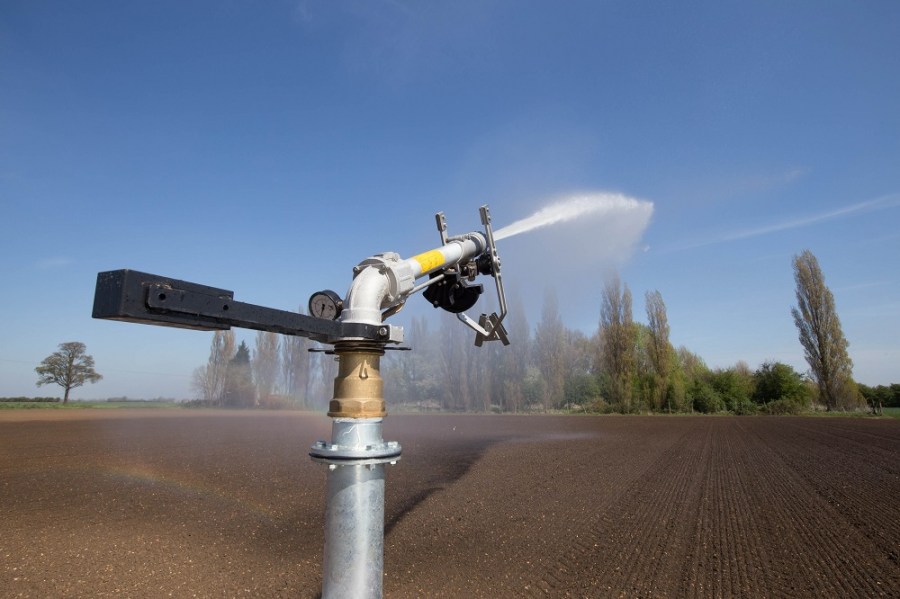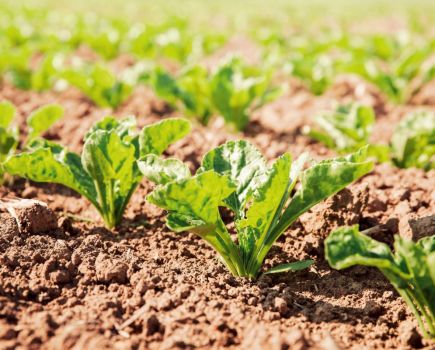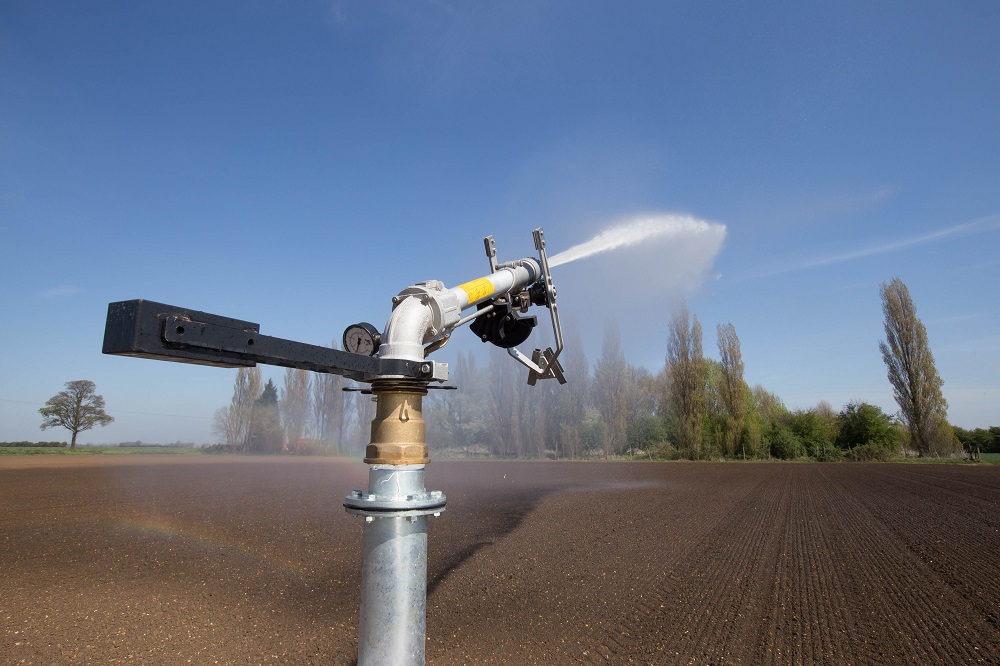
When it comes to irrigating potatoes, not all varieties are the same. CPM quizzes NIAB CUF on what their latest research means for growers.
Even the best growers frequently apply more water than is needed.
By Lucy de la Pasture
The old adage ‘quality always sells’ holds especially true when potatoes are in ample supply, as we’ve seen over the past few seasons.
Where irrigation is possible, keeping the soil moist around the time of tuber initiation is a tried-and-tested method of controlling the skin blemish disease common scab. However, achieving good common scab control isn’t just a matter of getting water on the crop, believes Dr Mark Stalham, research scientist at NIAB CUF.
A recently completed AHDB Potatoes-funded project highlights that a number of factors influence both the quality of scab control and the risk of over-watering.
The vast majority of potato growers (76%) use a hose-reel and rain gun, a system which often results in parts of the field receiving more water than necessary to make sure the majority of the crop receives sufficient water during the scab-control period.
Right balance
“Even the best growers frequently apply more water than is needed but it’s important that the right balance is struck

Over-irrigating can lead to effects such as growth cracking, lenticel eruption, internal rust spot, poor processing quality and tuber disease, says Mark Stalham.
While striving for adequate soil wetness during scab control, over-irrigating can lead to detrimental effects such as growth cracking, lenticel eruption, internal rust spot, poor processing quality and tuber disease,” he explains.
“In over-watered situations, plant growth can slow as a consequence of lack of oxygen supply for root respiration. Lenticels become erupted, disfiguring the tuber and dry matter can increase because the limited root system is unable to satisfy demand on hot days.”
Growth cracks are a physiological disorder where the tuber splits while growing, making tubers unattractive and difficult to peel, whether by hand or in a processing plant. Traditionally it’s been suggested that growth cracks occur as a response to fluctuating water stress, resulting in rapid changes in the rate of growth of tubers but work by Jefferies and MacKerron indicates that this isn’t the only reason for growth cracking.
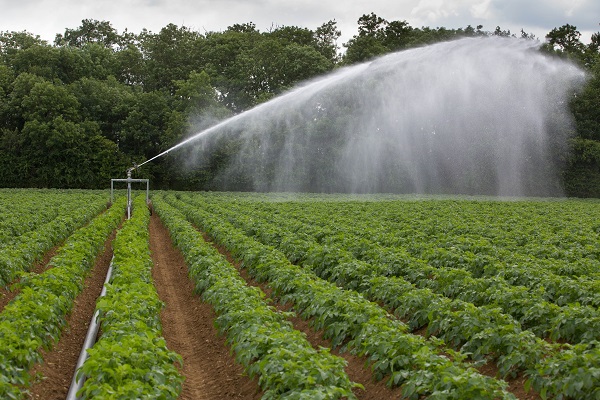
Avoid maintaining fields at, or over, field capacity during the 3-4 weeks after tuber initiation.
“If soil becomes wet again after being dry for long enough that tuber growth ceases altogether, that’s when growth cracks can occur. But another form of growth cracking can result when there’s rapid tuber growth and high turgor, usually associated with excessive rainfall or over-watering early in the life of the tuber,” explains Mark Stalham.
“The AHDB Project R448 found that under very wet conditions, if plants have an active rooting system, the tuber can take up extra water, making it very turgid. When the internal turgor pressure gets too high, the tuber will split, even at slow growth rates,” he says, adding that the form of cracking – from lenticel star cracks to severe longitudinal cracks – varies, depending on variety.
So how can you lessen the risk of growth cracks occurring in irrigated fields? Careful monitoring of soil moisture deficit (SMD) is a good starting point, reckons Mark Stalham.
“It’s particularly important to avoid maintaining fields at, or over, field capacity during the 3-4 weeks after tuber initiation and especially during the first week after tuber initiation. Using less irrigation (running higher SMDs) can reduce the risk considerably,” he advises.
Invading lenticles
The reason the tuber initiation period is so vital in preventing common scab is that the pathogens that cause the blemish, Streptomyces species, infect the tuber by invading undifferentiated lenticels while it’s developing.
The infected areas of the tuber respond by developing a corky layer of suberised tissue which enlarges as the tuber grows. As each layer is invaded by the Streptomyces through cracks or tears, new cork formation takes place until a mature scab lesion is produced.
“If no scab is visible four weeks after a tuber initiates (approx 35mm tuber diameter), it’s unlikely that infection will subsequently occur unless the periderm is ruptured through cracking,” explains Mark Stalham. “Peak pathogen populations are often found around four weeks after tuber initiation and generally decline thereafter.
“On the flip side, growers often don’t notice the pin-headed lesions at this stage and lesions can increase significantly in area as the tuber expands.”
Another finding in Project R448 was a large range in pathogen populations on tubers of susceptible and resistant varieties, which supports the theory that one mechanism for varietal resistance could be the suppression or inhibition of varietal growth, he believes.
So that raises the question, can irrigation be more tailored to the variety in the ground? “The industry and until recently, researchers, have traditionally taken a blanket approach to irrigation, treating each variety as if it was as susceptible to common scab as Maris Piper. The results of the recent research have meant we can group varieties according to their susceptibility, with the most susceptible varieties – those which develop the highest pathogen populations – such as Maris Piper in Group 1,” he explains.
Group 3 contains varieties with low susceptibilities, such as Electra, Lanorma, Orchestra and Vales Sovereign. These all have high resistance ratings of 7 or 8 for scab in the AHDB Potato Variety Database. Although the three Groups broadly reflect the resistance rating of the variety, this isn’t always the case, Mark Stalham points out.
“Group 2 contains the varieties with more intermediate susceptibility, with a few anomalies. There are varieties with high resistance ratings of 7, e.g. King Edward, Melody and Sylvana, where the irrigation scheduling is more critical for quality reasons. Maris Peer could be in Group 2 with a resistance rating of 5 but needs to be treated as a Group 1 variety due to the very low tolerance for blemishes in the salads sector.”
For practical purposes, the groupings will enable growers to take a more optimal and less rigid approach to their application of water. “With a Group 3 variety on a sandy soil, it’s possible to irrigate at a higher SMD and extend irrigation to 7-10 days for scab control. On heavier silt or clay soils, the interval between irrigation can extend to beyond 10 days,” he says.
The recent work has also resolved one of the issues for salad potato growers, where crops remain at risk from common scab infection for longer due to the small size of the tubers and the control period may extend to eight weeks.
“It appears that a six-week period of control is sufficient, even in Group 1 varieties, and this can be as short as 4-5 weeks in more resistant (Group 3) varieties,” explains Mark Stalham. “Shortening the control period will improve the rate of skin set and reduce disease, because soils can be allowed to dry out more prior to desiccation.”
- Mark Stalham and the NIAB CUF team are research partners at the three new AHDB Strategic Potato Farms (SPot) potatoes.ahdb.org.uk/Spot SPot (West) – WB Daw & Sons (Staffs); SPot (East) – Elveden Farms (West Suffolk); (SPot Scotland) – Bruce Farms (Perthshire).
- The science behind varietal susceptibility to scab and irrigation efficiency will be demonstrated this year in a commercial situation at SPot (East) with an Open Day on 5 July 2016
Fine tuning irrigation
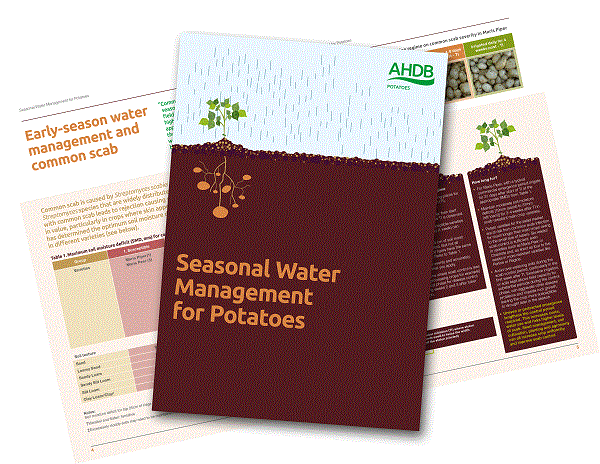 Use an accurate scheduling system, including measuring rainfall in each field.
Use an accurate scheduling system, including measuring rainfall in each field.- Calibrate irrigation equipment then maintain and operate correctly.
- Collect data on actual application rates and distribution patterns.
- Avoid soil compaction and excessively deep or fine destoning at planting to ensure free-draining ridges or beds.
- Begin irrigation when the first plants tuberise (2-3 weeks after emergence).
- Ensure the ridge or bed is close to field capacity by the time tuber initiation occurs in majority of plants.
- For further information, see Seasonal Water Management for Potatoes at potatoes.ahdb.org.uk/water
Maximum soil moisture deficit for common scab control in potatoes
| Group | |||
| 1. Susceptible | 2. Intermediate | 3. Resistant | |
| Varieties | Maris Piper (1)
Maris Peer (5) |
Charlotte (4)
Desiree (4) Estima (6) Exquisa Flair King Edward (7) Marabel* Melody (7) Nectar (6) Rooster (6) Sylvana (7) Safari * (4) Venezia Vivaldi (5) |
Bute (4)
Electra (8) Elfe Jelly (6) Lanorma (7) Orchestra (8) Perline Regina Vales Sovereign (7) Volare (5) |
| Soil Texture | Soil moisture deficit (mm) | ||
| Sand | 9.8 | 14.6 | 18.8 |
| Loamy Sand | 12.0 | 17.9 | 23.1 |
| Sandy Loam | 13.4 | 20.0 | 25.8 |
| Sandy Silt Loam | 14.4 | 21.5 | 27.7 |
| Silt Loam | 16.3 | 24.3 | 31.4 |
| Clay Loam/Clay** | 14.4 | 21.5 | 27.7 |
Source AHDB Potatoes; SMD for top 25cm of ridge and stone-free ridge profile; *Marabel and Safari: tentative; **Excessively cloddy soils may need to be maintained at a smaller SMD; Values in () are scores for common scab resistance in AHDB Potato Variety Database. 1 = most susceptible, 9 =fully resistant.
Survey call
AHDB Potatoes are urging growers of potatoes, field vegetables and protected crops to take part in a water-use survey. Fundamental reform of the UK’s water abstraction management system is on the cards as the UK Government responds to the Water Framework Directive, and reliable data about water use is needed to provide evidence to help shape this.
Growers who rent land and use irrigation and landowners with a licence should take the survey before the end of May (1 BASIS point will be awarded for taking part). www.surveymonkey.co.uk/r/VZ9R7VG
Stay flexible to keep ahead of blight
Flexibility is the key to keeping a lid on blight as the season begins in earnest, according to Suffolk independent agronomist Graham Tomalin.
“When the crop is past rosette stage and temperatures are beginning to rise, I start to keep a very close eye on forecast data from Blight Watch. But I’m also wary of not placing complete trust on any single forecasting model.
“The new blight strains, 13_A2 and 6_A1, can sporulate at lower temperatures than previously thought. What was once a ‘near miss’ according to Smith period calculations can result in blight outbreaks given the aggressive blight strains we now encounter,” he advises.
“For an effective control programme it’s best to start early at the rosette stage, using either cymoxanil plus mancozeb or fluazinam because you don’t have a big target to hit. During the rapid canopy growth stage, I favour systemic products such as propamocarb, either in combination with or alternating with translaminar products, depending on the risk. That gives on-going protection into the new growth,” he explains.
Another key to effective blight control is not to be too rigid on spraying intervals, he continues. “Balance the economics of the products with the need to upgrade your protection levels if the weather indicates higher disease pressure,” he advises.
That means starting the blight programme on a seven-day spray interval, but being ready to come down to three or four-day intervals quickly if the warnings signs are there or active blight is observed in the crop.
“If the overall risk of late blight is lower (as it was in 2015), I’d advise more cost-competitive products at the seven-day interval, or on shorter season crops it’s possible to extend the intervals if the risk is low,” he adds.
Newer blight products help to ensure blight doesn’t gain a foothold and that potential resistance issues are tackled by having more products in the mix, says Graham Tomalin.
“The combination of cymoxanil and fluazinam (Kunshi) is an important part of the armoury, particularly from full canopy onwards. I like the higher level of cymoxanil in this new combination.”
Cymoxanil provides good curative activity while protectant fluazinam has good activity on zoospores. “The combination also provides good protection against the risk of tuber blight,” he adds. Fluazinam also helps control sclerotinia, which is useful when potatoes are grown in the same crop rotation as carrots.
He also advises growers continue spraying right through to desiccation so the good work isn’t undone at the end of the season.

